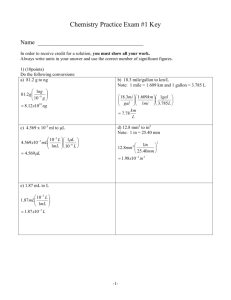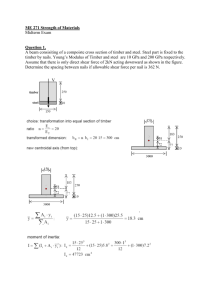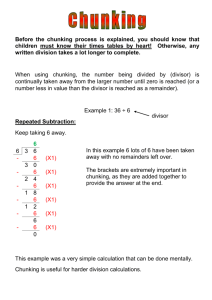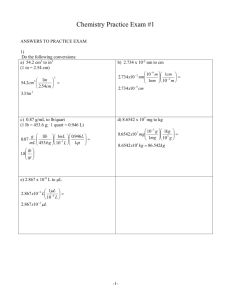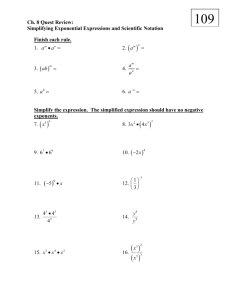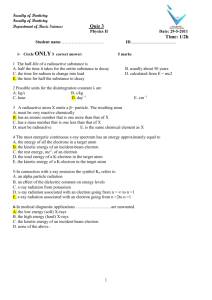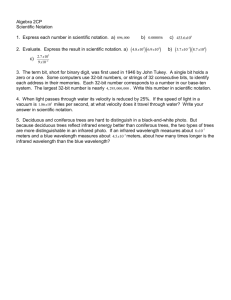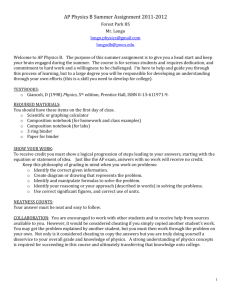22.01 Problem Set 1 Homework Solutions
advertisement
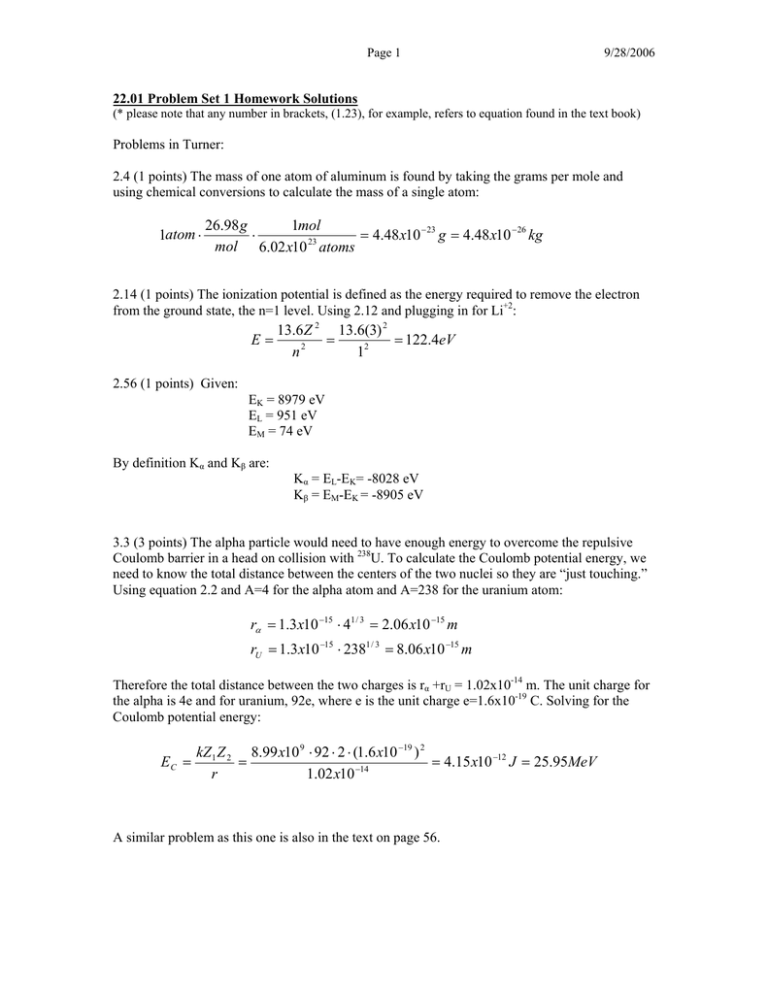
Page 1 9/28/2006 22.01 Problem Set 1 Homework Solutions (* please note that any number in brackets, (1.23), for example, refers to equation found in the text book) Problems in Turner: 2.4 (1 points) The mass of one atom of aluminum is found by taking the grams per mole and using chemical conversions to calculate the mass of a single atom: 1atom ⋅ 26.98 g 1mol ⋅ = 4.48 x10 − 23 g = 4.48 x10 −26 kg 23 mol 6.02 x10 atoms 2.14 (1 points) The ionization potential is defined as the energy required to remove the electron from the ground state, the n=1 level. Using 2.12 and plugging in for Li+2: E= 13.6Z 2 13.6(3) 2 = = 122.4eV n2 12 2.56 (1 points) Given: EK = 8979 eV EL = 951 eV EM = 74 eV By definition Kα and Kβ are: Kα = EL-EK= -8028 eV Kβ = EM-EK = -8905 eV 3.3 (3 points) The alpha particle would need to have enough energy to overcome the repulsive Coulomb barrier in a head on collision with 238U. To calculate the Coulomb potential energy, we need to know the total distance between the centers of the two nuclei so they are “just touching.” Using equation 2.2 and A=4 for the alpha atom and A=238 for the uranium atom: rα = 1.3 x10 −15 ⋅ 41 / 3 = 2.06 x10 −15 m rU = 1.3 x10 −15 ⋅ 2381 / 3 = 8.06 x10 −15 m Therefore the total distance between the two charges is rα +rU = 1.02x10-14 m. The unit charge for the alpha is 4e and for uranium, 92e, where e is the unit charge e=1.6x10-19 C. Solving for the Coulomb potential energy: EC = kZ1 Z 2 8.99 x10 9 ⋅ 92 ⋅ 2 ⋅ (1.6 x10 −19 ) 2 = = 4.15 x10 −12 J = 25.95MeV −14 r 1.02 x10 A similar problem as this one is also in the text on page 56. Page 2 9/28/2006 3.4 (2 points) The nuclear reaction is: 2 1 H + 01n → γ + 13H + Q The energy, Q, released in the decay is the difference in the masses between the parent nucleus and the daughter nuclei. Therefore, this mass difference can be expressed using the mass excesses, and can be written: Q = Δ parent − Δ daughter = Δ 2H + Δ n − Δ 3H = 13.1359 + 8.0714 − 14.95 = 6.2573Mev where mass excesses were obtained from Appendix D. This energy is the energy of the photon that is emitted. 1. (2 points) The nuclear reaction is: 2 1 H +13H → 24 He + 01n + Q The energy, Q, released in the decay is the difference in the masses between the parent nucleus and the daughter nuclei. Therefore, this mass difference can be expressed using the mass excesses, and can be written: Q = Δ parent − Δ daughter = Δ 2 H + Δ 3 H − Δ n − Δ 4 He = 13.1359 + 14.95 − 8.0714 − 2.4248 = 17.59 Mev 2). (3 points) a). When the alpha particle nears the gold nucleus, it will feel the Coulomb force. The Coulomb force, and energy, is dependent on a distance between two charged particles. Therefore the minimum distance that the alpha can approach the gold nucleus will be at which distance r the energy of the alpha particle equals the Coulomb potential of the gold nucleus: Eα = kZ1 Z 2 8.99 x10 9 ⋅ 79 ⋅ 2 ⋅ (1.6 x10 −19 ) 2 = = 1.2304 x10 −12 J = 7.69 MeV r r which gives an r = 2.955x10-14 m. Page 3 9/28/2006 b). This is the same type of question as 3.3 but for gold. Using equation 2.2 and A=4 for the alpha atom and A=238 for the uranium atom: rα = 1.3 x10 −15 ⋅ 41 / 3 = 2.06 x10 −15 m rAu = 1.3x10 −15 ⋅ 1971 / 3 = 7.56 x10 −15 m Therefore the total distance between the two charges is rα +rU = 9.624x10-15 m. The unit charge for the alpha is 4e and for gold, 79e, where e is the unit charge e=1.6x10-19 C. Solving for the Coulomb potential energy: EC = kZ1 Z 2 8.99 x109 ⋅ 79 ⋅ 2 ⋅ (1.6 x10 −19 ) 2 = = 3.778 x10 −12 J = 23.61MeV r 9.624 x10 −15 3). (4 points) The nuclear decay equation is: 239 94 Pu→ 24 He + 235 92 U + Q a). The energy, Q, released in the decay is the difference in the masses between the parent nucleus and the daughter nuclei. Therefore, this mass difference can be expressed using the mass excesses, and can be written: Q = Δparent – Δdaughter -Δα = ΔPu – ΔU -Δα = 48.6 – 40.93 – 2.4248 = 5.2452 MeV (3.13) ( * Note, this energy is shared between the alpha particle and the daughter nucleus) b). The energy of the alpha particle is determined by using the conservation of momentum and of energy. Section 3.3 in the text has a good description and proof of the following formula: Eα = MQ m+M (3.18) where M is the mass of the recoil daughter, and m is the mass of the alpha particle. Therefore, for the Radon decay: Eα = ( 235)(5.2452) = 5.157 MeV 4 + 235 Notice that most of the energy is given to the daughter nucleus. Using conservation of energy, the recoil energy of uranium is: EU = Q - Eα = 5.2452-5.157 = 0.088 MeV Page 4 9/28/2006 c). The mass of 1 alpha particle is: 1atom ⋅ 4.002 g 1mol ⋅ = 6.65 x10 −24 g = 6.65 x10 −27 kg 23 mol 6.02 x10 atoms The velocity of the alpha particle is: E= 1 2 mv 2 5.157 MeV = 8.25 x10 −13 J = 1 (6.65 x10 −27 )v 2 2 which gives v = 1.58x107 m/s. ( We can justify not using relativity because this is .05 the speed of light) 4). (6 points) a). First, we need to calculate the mass excess of 56Fe. We are given M = 55.934942 amu and A=56. Also 1 amu = 931.5 MeV, so: Δ 56 Fe = M − A = 55.934942 − 56 = −.065058amu = −60.602 MeV The nuclear equation to remove a neutron and the calculation of Q, the energy needed to remove the neutron: 56 26 Fe→ 01 n+ 2655Fe + Q Q = Δ parent − Δ daughter = Δ 56 Fe − Δ n − Δ 55 Fe = −60.602 − (−57.474) − 8.0714 = −11.2Mev As expected, you need to supply energy to remove the neutron. b) The nuclear equation to remove a proton and the calculation of Q, the energy needed to remove the proton: 56 26 Fe→11 p + 2555Mn + Q Page 5 9/28/2006 Q = Δ parent − Δ daughter = Δ 56 Fe − Δ p − Δ 55 Mn = −60.602 − (−57.705) − 7.2890 = −10.19Mev Again, as expected, you need to supply energy to remove a proton. c). In order to find the energy to completely dismantle 56Fe into individual components, we need to calculate the total binding energy of the atom, since this is the energy to break it apart into each part. Working in terms of amu, and then using the conversation factor ( 1 amu = 931.49 MeV): 1 proton = 1.0073 amu 1 neutron = 1.0087 amu 1 electron = .00055 amu First we sum up all of the energy from the total individual nucleons and electrons in 56Fe: ⇒ (number of protons*mass of protons) + ( number of neutrons*mass of neutrons) + ( number of electrons*mass of electrons) ⇒ 26(1.0073)+30(1.0087)+26(.00055) =56.4651amu (* Notice that the electron mass is so small that it could just be neglected) We know that some mass will be converted to energy. We can use mass excess, Δ, to calculate the mass of the Fe atom: Δ = M-A From above Δ = -0.0650588 amu, and A=56 amu: Δ= -0.0650588= M-56 M=55.9349 amu The difference in the mass between the total sum of nucleons and the actual mass of the atom gives the binding energy: B.E. = 56.4651-55.9349 = .5302 amu or 493.84 MeV The energy to dismantle the nucleus is therefore approximately 494 MeV. d). First, we need to calculate the mass excess of 28Al. We are given M = 27.981910 amu and A=28. Δ 28 Al = M − A = 27.981910 − 28 = −0.01809amu = −16.851MeV The nuclear equation to remove a neutron and the calculation of Q, the energy needed to remove the neutron: 56 26 28 28 Fe→13 Al + 13 Al + Q Page 6 9/28/2006 Q = Δ parent − Δ daughter = Δ 56 Fe − 2 ⋅ Δ 28 Al = −60.602 − 2(−16.851) = −26.9Mev 5) (2 points) a). The energy needed to excite an electron from the ground level, n=1, to the first excited level, n=2, in hydrogen is: ⎛ 1 1 ⎞ 1⎞ ⎛ 1 E = −13.6Z 2 ⎜ 2 − 2 ⎟ = −13.6 ⋅ 12 ⎜ 2 − 2 ⎟ = 10.2eV ⎜n ⎟ 1 ⎠ ⎝2 ⎝ f ni ⎠ (2.15) b). The orbital velocity of the n=2 level in hydrogen is: vn = k 0 Ze 2 nh (2.9) m 8.99 x10 9 ⋅ 1 ⋅ (1.6 x10 −19 ) 2 = 1.096 x106 v2 = − 34 s 2 ⋅ 1.05 x10 6) (5 points) a). Using the Bohr theory of the hydrogen atom, and extending it to titanium, the energy of the electron in its nth shell is: − 13.6 Z 2 eV E= n2 (2.12) where Z is the number of protons in the atom. Calculating now the E energy for levels: K shell: n=1 L shell: n=2 M shell: n=3 Z=22 (titanium) Gives: EK = -6.582 keV (-1.05x10-15 J) EL = -1.6455 keV (-2.633x10-16 J) EM = -0.7313 keV (-1.17x10-16 J) b). By definition Kα and Kβ are: Kα = EL-EK=4.9365 keV (7.867x10-16 J) Kβ = EM-EK =5.8507 keV (9.36x10-16 J) c). The energy of the emitted photon is proportional to the wavelength by: E= hc λ (2.13) Page 7 where h= 6.63x10-34 J*s, c=3x108 m/s, and getting λ in meters gives: λα = 2.53x10-10 m λβ = 2.12x10-10 m 9/28/2006
